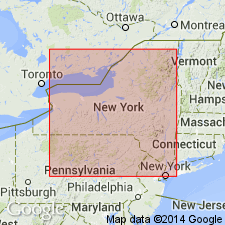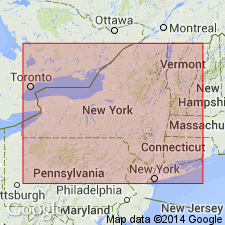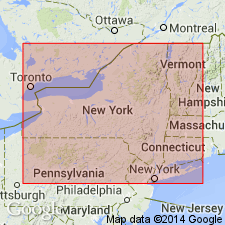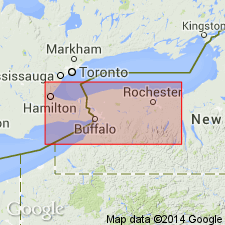
- Usage in publication:
-
- Whirlpool sandstone
- Modifications:
-
- Original reference
- Dominant lithology:
-
- Sandstone
- AAPG geologic province:
-
- Appalachian basin
Summary:
Pg. 238. Whirlpool sandstone. White quartzose sandstone, 25 feet thick, forming basal bed of true or Upper Medina [i.e. Medina restricted, later named Albion sandstone]. Overlain by red sandstones and green and gray sandstones and shale and underlain by Queenston shale, of Richmond age. Present in western New York and Ontario. Age is early Silurian.
Named from occurrence at the Whirlpool of Niagara River.
Source: US geologic names lexicon (USGS Bull. 896, p. 2317-2318).

- Usage in publication:
-
- Whirlpool sandstone member*
- Modifications:
-
- Overview
- AAPG geologic province:
-
- Appalachian basin
Summary:
In 1912 (New York State Mus. Hdbk., no. 19) C.A. Hartnagel included Queenston shale in Medina, and treated Whirlpool sandstone as an overlying part of Medina.
In 1913 (12th Intl. Geol. Cong., Canada, p. 26, 27, 30, 36, 49) E.O. Ulrich and J.M. Clarke replaced "Upper Medina" with Albion sandstone (a name suggested by Clarke); and A.W. Grabau (GSA Bull., v. 24, p. 431, 460) applied Whirlpool quartzite to basal 25 feet of that formation, to which, however, he applied Medina in a restricted sense. He described Whirlpool quartzite as hard white quartz sandstone, and stated that it occurred at Niagara and for some distance east and west, but not as far east as Rochester. In USGS Niagara Falls folio (No. 190, 1913) the form of the name was changed to Whirlpool sandstone member and the beds were described as consisting of 20 feet of coarse white sandstone, forming basal member of Albion sandstone and resting on Queenston shale. In Canada Geol. Survey Gdbk., no. 4, 1913, W.A. Parks proposed that Whirlpool sandstone of Grabau (consisting, at Hamilton, Ontario, of 10 feet of gray sandstone) be treated as basal member of Schuchert's Cataract formation [a name introduced by Schuchert in GSA Bull., v. 24, p. 107, 1913], "which represents an invasion from north and west at commencement of Silurian time" [but which, according to Schuchert, 1913, corresponds to lower 50 feet of the 135 feet of Albion sandstone at Niagara Falls]. Parks also restricted Medina to the beds above Cataract formation, or to uppermost part (60-70 feet according to F.B. Taylor on p. 22-24 of same volume) of beds formerly included in the Medina. The type locality of Cataract formation is a town in interior of Ontario, where it is also exposed at the cataract of Credit River. In 1914 (GSA Bull., v. 25, p. 277-320) Schuchert treated Whirlpool sandstone member as basal bed of his Cataract formation (and of Silurian system), and described it as consisting of 0 to 22 feet of coarse cross-bedded white, red, or mottled sandstone, extending from Lockport, New York, to near Collingwood, Ontario. He also stated that the white sandstones at base of Medina east of Lockport are not of same age as Whirlpool sandstone. The calcareous beds overlying the Whirlpool sandstone he designated Manitoulin limestone member, a name introduced by M.Y. Williams in 1913. E.M. Kindle, 1914 (Science, n.s., v. 39, p. 915-918), endorsed Grabau's restriction of Medina and treated Whirlpool sandstone as basal bed of that formation. M.Y. Williams, 1919 (Canada Geol. Survey Memoir 111), treated Whirlpool sandstone as basal member of Medina-Cataract formation, as did A.F. Foerste, 1924 (Canada Dept. Mines, Geol. Survey Memoir 138), who stated that Whirlpool sandstone extends from Niagara River to vicinity of Duntroon, about 8 miles south of Collingwood, and that it has not been traced as far east as Rochester, New York. In 1922 (Hdbk. Indiana Geol., pt. 4, Pub. 21) E.R. Cumings proposed that Albion sandstone be restricted to beds between Whirlpool sandstone and Thorold sandstone, and that Whirlpool be treated as basal formation of Medinan series.
W. Goldring, 1931 (New York State Mus. Hdbk., no. 10, p. 317), treated Whirlpool sandstone as basal bed of Albion sandstone as did H.L. Alling and J.E. Hoffmeister, 1932 (16th Intl. Geol. Cong. Gdbk., no. 4). This is the definition followed by the USGS [ca. 1938].
Source: US geologic names lexicon (USGS Bull. 896, p. 2317-2318).

- Usage in publication:
-
- Whirlpool Sandstone
- Modifications:
-
- Overview
- AAPG geologic province:
-
- Appalachian basin
Summary:
The Medina Group comprises 11 facies, which can be organized into three facies associations. The previously defined color-based formations do not conform with lithic correlations except for the Whirlpool and Manitoulin. A formal major revision is being proposed by Brett and others (in press) and Duke and others (in press). The newly revised Medina Group will include the Whirlpool Sandstone at its base (virtually unchanged), the overlying Jolley Cut Formation (a tentative renaming of the Manitoulin), the Balls Falls Formation (new), the Art Park Phosphate Beds (new), the Devils Hole Formation (new), the Grimsby Formation (revised), the Power Glen Formation (revised), the Thorold Formation (revised), the Cambria Formation (new), and the Kodak Formation (resurrected). The Medina unconformably overlies Queenston Shale; unconformably underlies Clinton Group.
Source: GNU records (USGS DDS-6; Reston GNULEX).

- Usage in publication:
-
- Whirlpool Sandstone
- Modifications:
-
- Overview
- Areal extent
- AAPG geologic province:
-
- Appalachian basin
Summary:
Unit forms the base of the Early Silurian Medina Group in southern Ontario and upper New York State. It is a major source of building stone. Two distinct mapping units are recognizable within the sandstone. Only the upper unit is marine in origin, deposited in a nearshore environment. The lower unit is probably of braided fluvial origin. Both are very fine to fine-grained subarkose to quartz arenite, with no notable compositional differences between the upper and lower units. Salt and pepper appearance is due to the presence of phosphatized fossil fragments. The Whirlpool is thin, and rarely exceeds 9 m in thickness. It extends a total of 275 km in outcrop along the Niagara Escarpment from Medina, NY, northward to Mitchell's Mill, near Duncan, Ontario. Unit extends southward into the subsurface of NY, OH, and PA, where it passes laterally into the Tuscarora Sandstone. Eastward, it pinches out between Medina and Rochester. Lower contact with Queenston Shale is a disconformity marking the Ordovician-Silurian boundary. Whirlpool passes upward into the Manitoulin Dolomite in the north and Cabot Head Shales in the south. Age is early Llandoverian.
Source: GNU records (USGS DDS-6; Reston GNULEX).

- Usage in publication:
-
- Whirlpool Sandstone*
- Modifications:
-
- Overview
- AAPG geologic province:
-
- Appalachian basin
Summary:
The Whirlpool Sandstone of the Medina Group in western NY consists of light-gray to white, medium- to coarse-grained, trough cross-bedded, quartzose sandstone with thin, dark-gray to greenish-gray shale clasts and interbeds. Unit contains floral microfossils. Thickness is 18 to 28 feet. Well exposed on Niagara Street at the railroad overpass, Lockport, Niagara Co., NY. Unit is lowest formation in Medina Group. Unconformably overlies the Upper Ordovician Queenston Shale and underlies the Power Glen Shale (contact is gradational over a few feet of interbedded sandstone and shale). Unit is mappable as far west as Hamilton, Ont, CAN, where in grades into carbonate of the Manitoulin Dolomite. To the east, near Medina, NY, the overlying Power Glen Shale pinches out, and the Whirlpool underlies the Devils Hole Sandstone (new). The Whirlpool is of Early Silurian age, probably early Llandoverian, based on correlation with the Manitoulin Dolomite. [Report uses Early and Late Silurian time scale of Harland and others (1982).]
Source: GNU records (USGS DDS-6; Reston GNULEX).
For more information, please contact Nancy Stamm, Geologic Names Committee Secretary.
Asterisk (*) indicates published by U.S. Geological Survey authors.
"No current usage" (†) implies that a name has been abandoned or has fallen into disuse. Former usage and, if known, replacement name given in parentheses ( ).
Slash (/) indicates name conflicts with nomenclatural guidelines (CSN, 1933; ACSN, 1961, 1970; NACSN, 1983, 2005, 2021). May be explained within brackets ([ ]).

